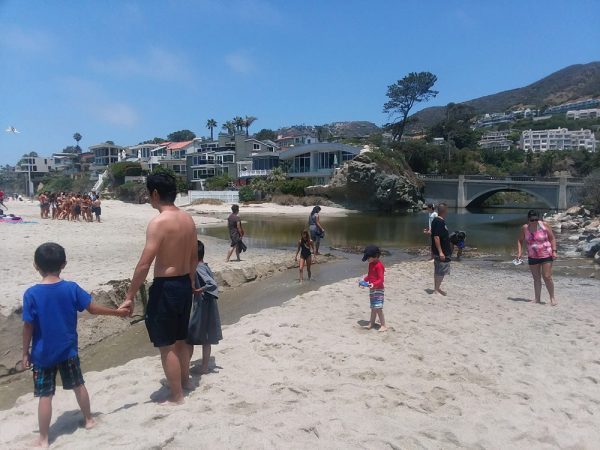By Gabrielle Mix, Special to the Independent
Two sections of Laguna Beach shoreline, Victoria Beach and North Aliso County Beach, earned a spot on the Honor Roll in the annual report card on pollution of public coastal areas compiled by Heal the Bay.
The two Laguna beaches received exceptional grades in all seasons and all weather conditions, according to the environmental non-profit’s 28th annual report, which was released June 7. The rest of Laguna’s beaches received mostly A’s with some F’s sprinkled in the mix.

Water spilling from the mouth of Aliso Creek and 1,000 feet south along Aliso Beach were responsible for the majority of these F’s under the wet-weather, year-round category. But the beach also received A’s in the remaining two categories, summer and winter dry.
However, the report is controversial, with one environmental group questioning whether swimmers should take seriously Heal the Bay’s ratings.[1]
Jinger Wallace, of the Laguna Bluebelt Coalition, an ocean conservation group, called Heal the Bay’s report “disappointing” for failingto acknowledge water-quality testing that is limited solelyto bacteria that can cause illness in humans. “None of the other constituents of concern that result from urban runoff are considered,” she said.
Karen Vu, Heal the Bay’s Beach water quality analyst, said the organization should not be to blame for this shortcoming. She said, “the amount of sampling is up to the county to decide based on funding and staffing.”[2]
Some of the beaches that received all A and B ratings in the recent report include Emerald Bay, Crescent Bay, Laguna Main Beach, Salt Creek and Crystal Cove.[3]
Three Southern California beaches are among the 10 most polluted in the state, including Poche Beach in San Clemente, with the worst ratings.
In total for Southern California, the report compiles data from 336 test locations for the summer dry season, 252 locations in winter and 305 locations tested for year-round wet-weather.[4]
Steve Greyshock, of the South Orange County Wastewater Authority, said “it’s our understanding that they utilize data that we submit through the county.” He said, “these tests are done in strict accordance to state and federal regulations to help ensure public health. As required by law, we test for the bacteria that, if present, could cause illnesses.”
SOCWA partners with county staff, the state Regional Water Quality Control Board and other agencies to collect and test about 3,500 ocean samples each year.[5]
Vu said “at this point, the report only considers the fecal indicator bacteria.” She explained that this type of bacteria is not necessarily harmful itself but points to the presence of bacteria that can make people sick.[6]
Heal the Bay’s ratings are important for the public to consider because, according to the county’s health care agency, “contaminated runoff and untreated sewage released into ocean and bay waters may result in swimmer exposure to pathogenic bacteria, viruses or protozoa.”
Even aside from untreated creek runoff,Wallace said, “drugs, medicines or microbes that cannot be eliminated by sewer treatment plants” is also discharged 1.2 miles offshore of Aliso Beach from a sewage treatment plant outfall pipe. “The public falsely believes that ocean water quality is healthy,” she said.
Aliso Creek has been declared an “impaired water body” under the Clean Water Act, according to the California Regional Water Quality Control Board. Those designated pose “immediate public health risks,” according to the water board.
Signs along the creek mouth at Aliso Beach warn against entering the polluted water.
Wallace finds it “pretty incongruous for HTB to say it’s healthy when the sign is warning people of the polluted urban runoff running across the beach and into the surf zone and where people swim.”
Aliso Creek’s poor water quality helps explain why the Aliso beaches received F grades for the wet weather category due to runoff.
Mike Beanan, also a member of the Bluebelt Coalition, said Heal the Bay’s reliance on bacteria testing misses other pollutants. “That means high nitrogen levels, high phosphorous levels, possible high ammonia levels,” he said.
Beanan and Wallace contend the Heal the Bay ratings inaccurately portray water quality on some of Laguna’s most popular beaches.
Despite criticism that the report neglects to include all harmful contaminants, Vu believes Heal the Bay uses the information provided by county agencies and successfully translates it in a way that is informative and easy for the public to understand.
Due to Southern California’s drought-like conditions this past year, most of its beaches are cleaner. Lack of rain has meant less bacterial pollution flowing into coastal waters. During the summer dry season, 95% of beaches earned A grades, 5% more than the five-year average, the report said. [7]
Top beach rankings make life easier for Ashley Johnson, president and chief executive of Visit Laguna Beach, the city’s promotion arm. “Our pristine beaches are not only ideal for maintaining a healthy sea life population, but are also important factors when planning a vacation to a beach destination” she said.
Vu said, “we strongly believe that no one should get sick from a day at the beach.”[8]
For Heal the Bay’s recent Report Card, visit healthebay.org.




